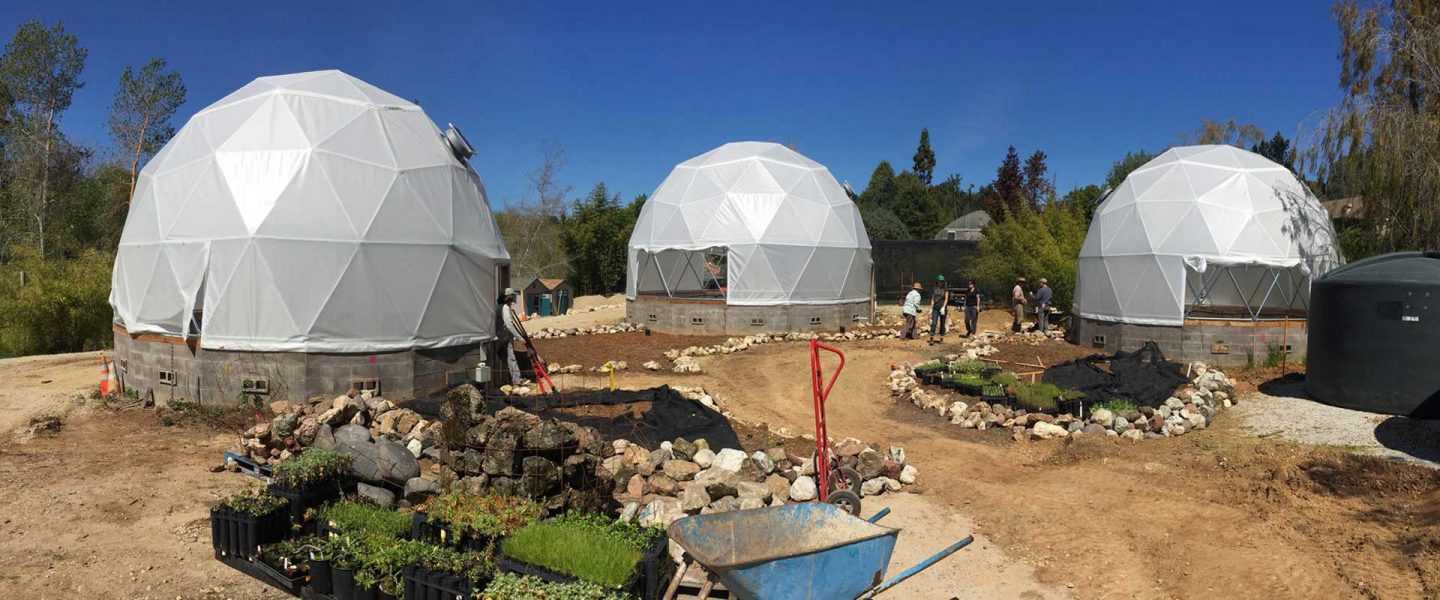“We are propagating plant ensembles inside three Buckminster Fuller geodesic-engineered greenhouse domes manufactured by Pacific Domes“
UC Santa Cruz Arboretum
The UC Santa Cruz Arboretum and Botanic Garden is home to Future Garden, a dynamic and diverse ‘ecosystemic’ installation, overseen by UCSC professor emeritus, Newton Harrison. Professor Harrison and his late wife Helen Mayer Harrison worked in tandem with botanists and students at the Arboretum to create experimental/research gardens inside of three geodesic greenhouse domes donated by Pacific Domes of Southern Oregon.
Harrison is driven by his vision for mitigating and rectifying the negative impact on ecology brought about by climate change. Throughout his 50-year career he has taught his principles and explains, the future of gardening and growing food lies in identifying durable and complementary plant species to create ecosystems that flourish as temperatures increase. An array of plant species native to the northern California coast are being cultivated in systems mimicking temperatures and water conditions projected for the region in the future.
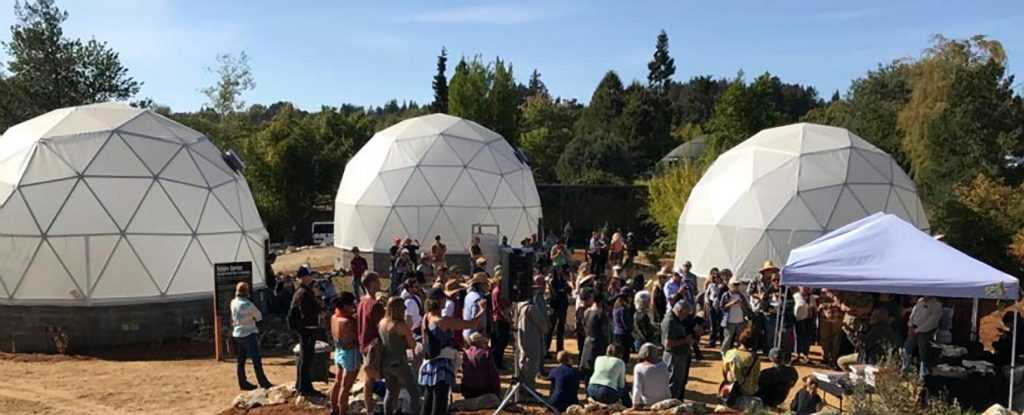
According to the Institute for Arts and Sciences, “the fantastical domes are role models for how people can take responsibility for a deeply stressed planet.”
The Future of Food with Greenhouse Domes
The futuristic looking greenhouse domes at the Arboretum provide a perfect backdrop for imagining a future in the midst of climate change. The climate inside a geodesic dome can be ‘tuned’, making them ideal structures for testing our ability to rise to the challenge by growing plants in a sustainable ecosystem.
For research purposes the temperature in the Future Garden domes is held at 10° degrees Fahrenheit higher. As local temperatures rise in the future, rainfall will, either, increase or decrease. Each dome has a unique watering system that emulates these future variables.
Self-sufficiency: Growing Your Own Food
The recent pandemic has caused many of us to consider the future of our own food supply. As self-sufficient individuals, how do we preserve and protect our access to the diverse food supply that we are accustomed to?
What better time to re-imagine the future of individual or community greenhouse growing than during challenging times? Imagine your food coming from a local Community Greenhouse Food Garden, instead of having to be shipped long-distances from another part of the country or world!
Community Food-Gardens, yesterday’s Victory Gardens, are having a resurgence in today’s uncertain climate. The Victory Garden movement began during WWI when Americans were called upon to become self-sufficient and grow food in whatever spaces they could find.
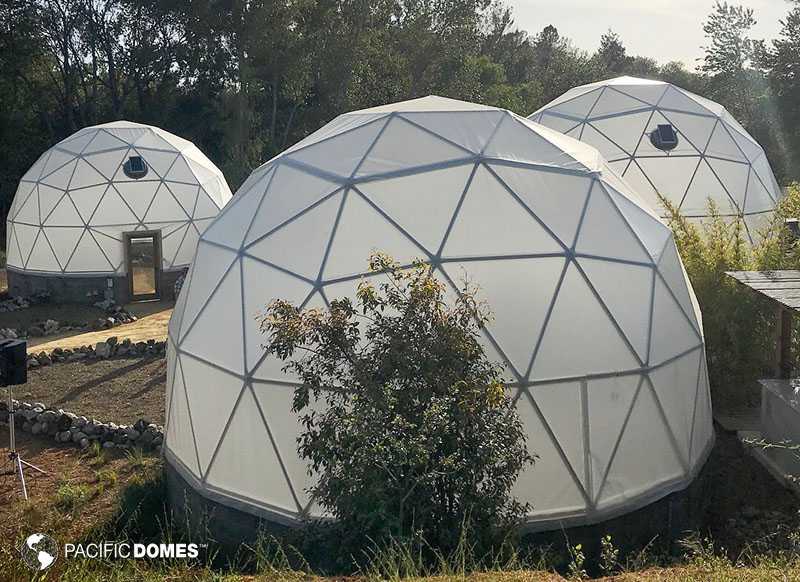
5 Benefits of Greenhouse Domes
- Strength: Arguably, the most obvious benefit is the superior geodesic-engineered strength of prefab BioDome greenhouses, making them the strongest greenhouse structure known to man. Due to their inherent ability to withstand the forces of nature – such as extreme temperatures, winds and earthquakes – geodesic dome structures have been erected worldwide.
- Sustainability: The second important benefit, aptly defines today’s buzzwords of building sustainably by weaving and leaving a light eco-footprint. Portable prefab BioDome greenhouses come in many sizes and are suited to sensitive Ecocentric (nature-centered) environments – and, they can be assembled quickly with basic hand-held tools.
- Spaciousness: Buckminster Fuller discovered the doing more with less principle, in that the dome encloses the largest volume of interior space with the least amount of surface area, thus saving on materials and cost. Bucky Fuller reintroduced the idea that when a sphere’s diameter is doubled, it will quadruple its square footage, producing eight times its volume.
- Synergistic: A benefit derived from extensive research into bio-geometrical shapes, further fuels scientific conclusions that the inherent frequency of geodesic architecture produces the highest vibrational environment beneficial to both humans and healthy plants.
- Efficient: According to the Buckminster Fuller Institute, geodesic domes’ concave interior “creates a natural airflow that allows the hot or cool air to flow evenly throughout the dome with help from return air ducts. Extreme wind turbulence is lessened because winds that contribute to heat loss flow smoothly around the dome. Additionally, the spherical dome shape acts like a type of giant downward reflector, concentrating interior heat and preventing radiant heat loss.”
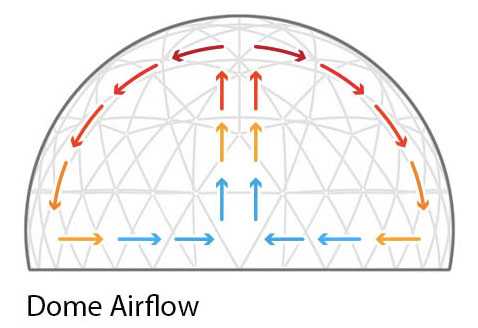
Inspiring innovation through education, Pacific Domes mission-driven goal is to empower communities to grow their own farm-to-table food. As the strongest structures known to man, our long-lasting and durable geodesic greenhouse structures are designed to withstand the test of time.
Pacific Domes Greenhouse Domes, Future Garden, UC Santa Cruz (3:40 min)
Professor Newton Harrison and his team explain how three Pacific Domes Greenhouse Domes are being utilized by the University Arboretum to grow coastal-native plants which are resistant to drought, part medicinal, part edible and part the basis for biodiversity, supporting a healthy food chain for birds and butterflies.
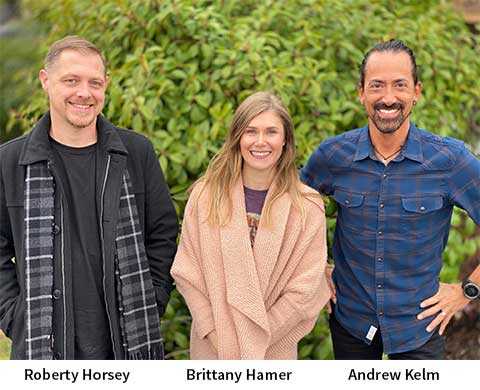
Let’s build a sustainable future together. Pacific Domes is here to support you each step of the way. Give our friendly Sales team a call to get started with your Community Greenhouse Food-Garden today.
